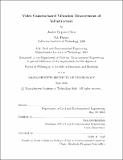Video camera-based vibration measurement of infrastructure
Author(s)
Chen, Justin Gejune
DownloadFull printable version (50.96Mb)
Other Contributors
Massachusetts Institute of Technology. Department of Civil and Environmental Engineering.
Advisor
Oral Büyüköztürk.
Terms of use
Metadata
Show full item recordAbstract
Functional infrastructure-including transportation, energy, and buildings and other facilities - is key to the economic production of a country and the daily lives of its people. Due to deterioration and potential damage, timely inspections and repairs are necessary to keep infrastructure functioning at full capacity. Visual testing is one of the oldest and most widely used methods for condition assessment; however, this technique is limited since it is based on an inspector's subjective rating rather than on an objective quantitative measure of structural condition. Quantitative alternatives to visual testing have emerged over time. These include vibration analysis, in which a structure's operational resonant frequencies and mode shapes are measured and compared against a healthy baseline to detect changes. Typically, contact sensors such as accelerometers have been used to measure vibrations. When physical access to a structure is limited or the placement of contact sensors is too time-consuming, new technologies that allow for non-contact measurements can be used. Video cameras, where each pixel is effectively a sensor, can remotely collect a large amount of data from a structure. The challenge is then to interpret these videos into quantitative vibration data. In this research, newly developed computer vision techniques for analyzing small motions in videos and their application to the vibration measurement and condition assessment of infrastructure are presented. These techniques allow for qualitative visualizations of normally imperceptible motions as a form of enhanced visual testing, and quantitative measurements of the displacements and vibrations of structures as a basis for condition assessment. Computer vision algorithms for processing video are described and the technique is experimentally validated against traditional sensors. The methodology is demonstrated with a series of laboratory measurements of simple representative structures and field measurements of civil infrastructure, including the WWI Memorial Bridge in Portsmouth, New Hampshire.
Description
Thesis: Ph. D., Massachusetts Institute of Technology, Department of Civil and Environmental Engineering, 2016. This electronic version was submitted by the student author. The certified thesis is available in the Institute Archives and Special Collections. Cataloged from student-submitted PDF version of thesis. Includes bibliographical references (pages 257-266).
Date issued
2016Department
Massachusetts Institute of Technology. Department of Civil and Environmental EngineeringPublisher
Massachusetts Institute of Technology
Keywords
Civil and Environmental Engineering.